Why This Little Known 4 Step Structure Builds Mental Toughness in Amateur and Professional Golfers3/8/2013
 When you hear the term ‘mental toughness’ in golf what do you think it relates to? Do you think it describes a tough minded professional golfer with a ‘never give up’ attitude - a golfer who just keeps bouncing back from bad breaks and setbacks on the golf course? Sports psychologist Jim Loehr has described mental toughness this way: “Mental toughness is the ability to consistently perform towards the upper range of your talent and skill regardless of competitive circumstances.” Before we explore what I think mental toughness is for golfers (I think it is quite a different form of toughness to other sports) let me ask you a simple question: “What would the ideal mindset be for someone playing a sport where you spend more than 5 hours at the venue but only perform it for less than one percent of that time?” Interesting question right? Golf is one of the most challenging of all sports because you have a lot of time where you are not doing much more than walking to your ball. So out of five hours on the golf course if you say that each golf stroke from putting to tee-shots takes about two seconds to perform and your golf stroke average was 80, then you would be actually performing at golf for about 2 minutes and 40 seconds out of the five hours that you are on the golf course. If my math is correct you are actually executing golf strokes for less than one percent of the total time you spend on the golf course! But let’s go back to my question again and rephrase it slightly. “what would the ideal mindset be for someone playing golf where you spend more than 5 hours on the golf course but only perform your golf strokes for less than one percent of that time?” Golf is one of the few sports where you spend an inordinate amount of time not performing! In most sports you are performing for most of the time that you are there. I bet you can understand why the game is so difficult if you consider the amount of random thoughts that go through your mind every ten seconds? 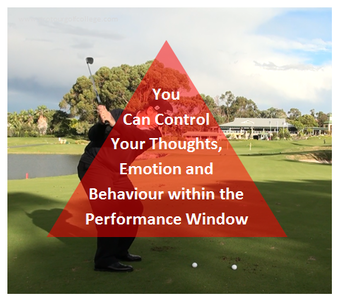 And the thing about all these random thoughts is that they’re completely normal and are not really a problem except when those thoughts (that are not real by the way) somehow influence your decision making process prior to hitting a golf shot in a negative way. You know the “don’t hit it there” type of thinking? To translate Jim Loehr’s quote another way; mentally tough golfers have developed their ability to consistently perform to the best of their current level of ability when they are hitting a golf shot anytime and anywhere. So let’s say that you take 80 strokes the next time you play a round of golf. There will be 80 separate times over five hours where you will have to go through the process of hitting a golf shot from all sorts of places on the golf course with the goal of producing the best score you can at the end of every hole. 80 separate times. The Golf Performance Window Now the top professionals take between 12 and 18 seconds to walk into their shot and hit it and what we have discovered is that their routine from one stroke to the next over 18 holes varies by less than one second every time. They can manage their thoughts consistently within a 12 to 18 second performance window. 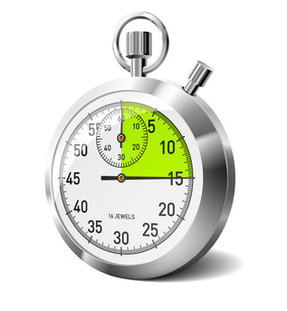 Here’s a quick exercise that I want you to try right now. Take your stop watch out, or if your phone has a timer on it set the timer to fifteen seconds. Now when you push the start button I want you to attempt to think about just one single thought until the buzzer goes off at fifteen seconds. How did you go? Not easy is it? In-fact it almost impossible to hold just one conscious thought over fifteen seconds. Buddhist monks who meditate everyday for their entire life to develop stillness of mind would find it difficult to keep one conscious thought over 15 seconds. So your mind cannot be as blank as a canvas before the paint, and your mind cannot be blank before you hit your shot. You are going to have some thoughts so you need to make sure that these thoughts have a consistent structure to them, just as if you were taking a lesson from your golf instructor to develop some aspect of your golf swing technique and a step-by-step structure would be employed. 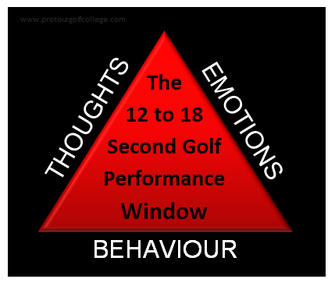 A Thinking Structure is the Key Structure leads to stability and stability leads to consistency. Basically you are controlling two structural factors to influence a third. The two structural factors are your thoughts and your emotions (feelings) to influence your behavior (action) within the performance window. Think about a time recently on the golf course where your thinking influenced your feelings about a shot in a negative way and the result was a poor shot. Your structure needs a thought strategy - not just a physical one like your pre-shot routine. What’s the point of having a great physical routine if your pre-thoughts and feelings routine is inconsistent or just plain awful? Your pre-shot routine should involve a great thinking/feeling structure that becomes as consistent as your physical routine. Have you noticed that professional golfers have a certain behavioral style that is consistent from golfer to golfer. Notice how different they react compared to sportsmen and women from other types of sports. They are much more conservative with the use of their emotional energy. They are slower and more deliberate which is consistent with the nature of the game. For example up-time is 1 percent and down-time is 99 percent. How should you act in a sport with those ratio's? Because you’re out there on the golf course for a very long time the discipline you seek is to be consistent at keeping your emotions in check. More physical and fast moving sports have a very different mental makeup, and a very different type of toughness compared to golf. To be tough in golf is to be consistent at performing your mental/physical routine within the 12 to 18 second window and The Golf Performance Dashboard will help you organize your thoughts so that it leads to feelings you can trust, and golf swings that produce more good golf shots during your round. 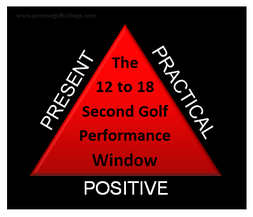 The Golf Performance Dashboard If you've ever watched any type of car race you know that the driver drives the car using instruments that help him/her know how the cars engine is performing at any time during the race. Their skill is in managing the different factors to keep their engine performing optimally is the key to performing to the best of their ability. Remember your thoughts are operating within a 12 to 18 second performance window (your pre-shot routine) and your job is to manage four factors on the following dashboard on every shot you play.
The great thing about the golf performance dashboard is that it helps you to develop a simple thinking strategy that leads you through the performance window. Remember that it is important to have a good structure for executing your pre-shot routine, but without a good thinking strategy to compliment it, it will be ineffective. It will be helpful to go through a golf performance window time check on the practice fairway to calibrate your mental/physical routine so you can match it up to within a second each and every time. The following simple model will help you to do this and my recommendation is to do this as soon as possible to see how consistent and effective your pre-thinking-shot-routine is. You can see in the example the variation between shots and in the summary column the actual difference in time from one club and another. Also get your coach, playing partner, in-fact anyone who can help you to periodically time your routine on the golf course when you are not aware of it. Time 10 shots over 18 holes and then compare each time window to see how consistent or inconsistent you are. Is the time the same on the practice range to the golf course for the same clubs? But what does it look like when you don’t manage your thoughts within your pre-shot routine? For example let’s say that you have a habit of focusing too much on results in the past and this influences you to force your game to amongst other things try to play crazy golf shots that rarely - if ever come off. You might think that you are confident at pulling the shot off but you are kidding yourself, and as a result you will not be enjoying playing each shot as it comes because you will spend your moments not where you’re standing but more than likely thinking about how unfortunate you've been and that you have no luck! Your dashboard might look something like this. You can see that there’s a fine line between playing well and playing poorly and your thoughts during your pre-shot routine will definitely be the main factor in whether you will feel confident and in control of your game, or whether you feel out of control.
You’ll discover that managing these four factors on the golf performance dashboard on every golf stroke will help you develop and manage two crucial elements; feel and trust. When you play golf shots you rely on the feel of your stroke from putt to drive, and trust is directly connected to your feel, and your feel is directly related to the thoughts you have within your 12 to 18 second window. If you manage these simple metrics you will manage your golf stroke performance from shot-to-shot. This is what mental toughness is for a golfer. Manage your thoughts within the golf performance window over and over. This simple dashboad structure will guide the type of thoughts that will lead you to lower golf scores and better performances when it matters. So give it a try and plug your mental game into the golf performance dashboard and measure your four performance factors inside your performance window to find out where your thinking is at right now. Lawrie Montague and David Milne - Pro Tour Golf College Your Success On Tour Is Our Business 3/8/2013 08:08:19 am
Lawrie,David, 3/8/2013 12:06:57 pm
Thanks again John we're really glad that you enjoy our articles and especially feedback on its practicality and relevance which is always our aim.
Jon Sielsky
3/8/2013 06:34:39 pm
Great article Lawrie. 4/8/2013 04:01:14 am
Hey John thanks so much, I really appreciate your feedback and trust that you are well. Comments are closed.
|
Archives
June 2019
|
Proudly Supported By
Copyright © 2011 - 2018 Pro Tour Golf College
Website Managed By Golf Performance Media
All Rights Reserved
Website Managed By Golf Performance Media
All Rights Reserved

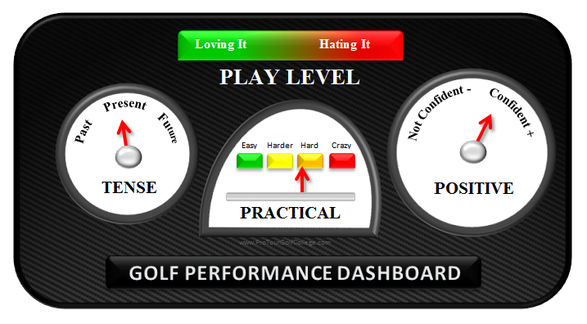

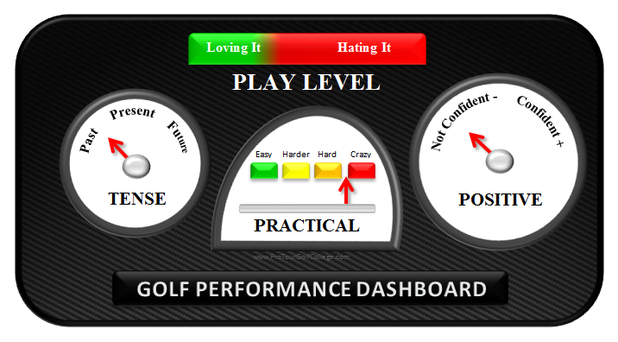
 RSS Feed
RSS Feed



